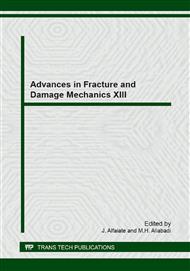p.29
p.33
p.37
p.41
p.45
p.49
p.53
p.57
p.61
Fatigue Life Assessment of Self-Expandable NiTi Stent
Abstract:
Objectives: This paper presents a numerical fatigue life assessment of a self-expandable Nitinol stent. The analysis was performed using the ANSYS 11 software. Methods: Stent durability is an issue which must be addressed during the design of implants. Given the corrosive properties of blood and the cyclic loads that are applied on the stent (the cyclic variation of blood pressure), the determination of fracture parameters and fatigue characteristics of the implant is highly recommended. Breaking of the stent’s wire is particularly dangerous because it can cause the dislocation of a piece of stenotic plaque, which in turn can block a smaller artery, causing a heart attack. On the other hand, any discontinuity in stent structure acts as an accumulating place for stenosis particles, significantly shortening the life of the implant. The stent consists of a cylindrical tube 22.42 mm long, with a diameter of 8.3 millimeters. The wire section is square, 0.2x0.2 millimeters. The stent is only subjected to the pressure generated by the stenoted arterial wall. This evenly distributed pressure is defined at the outer surface of the stent and has a value of 2.5 MPa, corresponding to a 56% blood vessel stenosis. This way, the most severe loading conditions for the stent could be simulated. The stress distribution was then used to asses the fatigue life of the stent. Results and conclusions: The results showed that, in normal conditions (with the maximal internal pressure of 139 mm Hg = 18533 Pa), no damage appears on the stent after 107 cycles.
Info:
Periodical:
Pages:
45-48
Citation:
Online since:
September 2014
Authors:
Price:
Сopyright:
© 2015 Trans Tech Publications Ltd. All Rights Reserved
Share:
Citation:


